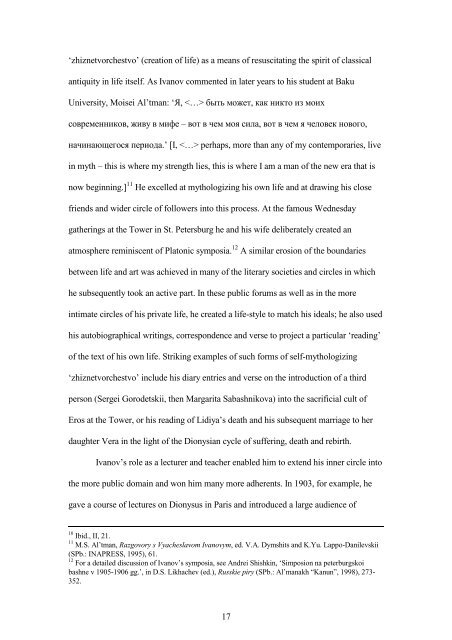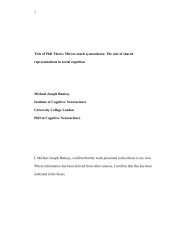Vyacheslav Ivanov and C.M. Bowra: a ... - UCL Discovery
Vyacheslav Ivanov and C.M. Bowra: a ... - UCL Discovery
Vyacheslav Ivanov and C.M. Bowra: a ... - UCL Discovery
You also want an ePaper? Increase the reach of your titles
YUMPU automatically turns print PDFs into web optimized ePapers that Google loves.
‘zhiznetvorchestvo’ (creation of life) as a means of resuscitating the spirit of classical<br />
antiquity in life itself. As <strong>Ivanov</strong> commented in later years to his student at Baku<br />
University, Moisei Al’tman: ‘Я, быть может, как никто из моих<br />
современников, живу в мифе – вот в чем моя сила, вот в чем я человек нового,<br />
начинающегося периода.’ [I, perhaps, more than any of my contemporaries, live<br />
in myth – this is where my strength lies, this is where I am a man of the new era that is<br />
now beginning.] 11 He excelled at mythologizing his own life <strong>and</strong> at drawing his close<br />
friends <strong>and</strong> wider circle of followers into this process. At the famous Wednesday<br />
gatherings at the Tower in St. Petersburg he <strong>and</strong> his wife deliberately created an<br />
atmosphere reminiscent of Platonic symposia. 12 A similar erosion of the boundaries<br />
between life <strong>and</strong> art was achieved in many of the literary societies <strong>and</strong> circles in which<br />
he subsequently took an active part. In these public forums as well as in the more<br />
intimate circles of his private life, he created a life-style to match his ideals; he also used<br />
his autobiographical writings, correspondence <strong>and</strong> verse to project a particular ‘reading’<br />
of the text of his own life. Striking examples of such forms of self-mythologizing<br />
‘zhiznetvorchestvo’ include his diary entries <strong>and</strong> verse on the introduction of a third<br />
person (Sergei Gorodetskii, then Margarita Sabashnikova) into the sacrificial cult of<br />
Eros at the Tower, or his reading of Lidiya’s death <strong>and</strong> his subsequent marriage to her<br />
daughter Vera in the light of the Dionysian cycle of suffering, death <strong>and</strong> rebirth.<br />
<strong>Ivanov</strong>’s role as a lecturer <strong>and</strong> teacher enabled him to extend his inner circle into<br />
the more public domain <strong>and</strong> won him many more adherents. In 1903, for example, he<br />
gave a course of lectures on Dionysus in Paris <strong>and</strong> introduced a large audience of<br />
10<br />
Ibid., II, 21.<br />
11<br />
M.S. Al’tman, Razgovory s <strong>Vyacheslav</strong>om <strong>Ivanov</strong>ym, ed. V.A. Dymshits <strong>and</strong> K.Yu. Lappo-Danilevskii<br />
(SPb.: INAPRESS, 1995), 61.<br />
12<br />
For a detailed discussion of <strong>Ivanov</strong>’s symposia, see Andrei Shishkin, ‘Simposion na peterburgskoi<br />
bashne v 1905-1906 gg.’, in D.S. Likhachev (ed.), Russkie piry (SPb.: Al’manakh “Kanun”, 1998), 273-<br />
352.<br />
17
















